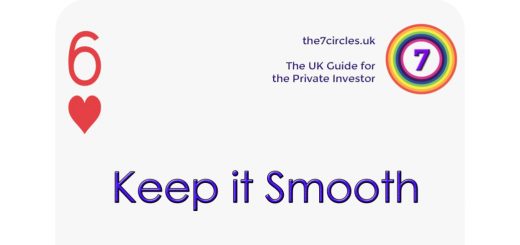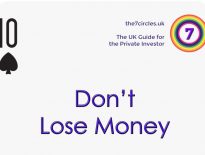9♥ – Follow The Smart Money
Follow the Smart Money - you can save time and effort by watching "the best"
This post is part of the MoneyDeck series, a pack of 52 playing cards that describe 52 “golden rules” for Private Investors in the UK.
Follow the Smart Money – you can save time and effort by watching “the best”
Today we’re going to talk about how you can follow the smart money, by taking advantage of the trades and signals from market professionals.
Let’s start by making it clear that we don’t really mean that these guys are smarter than us.
- Smart money is just a longstanding industry term for insiders.
Retail money in aggregate is “dumb”, since it tends to buy at the top and sell at the bottom.
- Witness the catastrophic underperformance of private investors (PIs) relative to the funds that they invest in – up to 7% pa.
- PIs make decent stock-pickers but terrible market timers, according to the research.
I trust that my readers don’t fall into this category of “dumb money”.
Some of the smart money guys really will be smart, a few will be very smart, but plenty will be dead average.
- But they are full-time professionals.
- And they have access to information and expensive tools and equipment that we as private investors probably can’t access or afford.
- So they have three potential advantages – time, money and tools, and early information.
The second thing to say is that we aren’t talking about what’s legally defined as insider information.
- We aren’t planning to make friends with “Deep Throat” and find out what’s really going on inside our favourite firm.
Some of the signals we’ll be looking for are indirectly based on inside information, but we’ll never need to know precisely what that information is.
- We can just look for the signals.
So who are these guys?
They fall into four main groups:
- company executives (normally known as directors)
- professional investors (fund managers)
- sell-side analysts
- short sellers
We’ll address each of these groups in detail in a future series of posts.
- But for today we’ll just provide an overview of how you can take advantage of the public actions of each set of market players.
The first group to consider is company directors.
There are rules around when company directors can trade.
- They are banned from trading within six weeks of company results, for example, or when there is price-moving information that has not yet been released to the public.
But despite these restrictions, their trades still provide information.
- Even outside the restricted periods, directors will have a good idea of the true prospects of the firm, and they are likely to buy only when they believe that the fair value of the company exceeds the current share price.
Note that sales by directors are less informative.
- They have a natural incentive to diversify their holdings away from the firm they work for (up to a point)
- And sales can simply reflect a short-term need for cash (or just the exercising of share options).
When directors buy, the company’s shares usually outperform – often by more than 20% pa.
This is particularly the case when:
- three or more directors buy within a period of three months
- they buy a significant number of shares
- the CEO and / or CFO are involved, or shareholders with more than a 10% holding
- it’s a small or distressed stock
- it’s a stock in a defensive rather than cyclical sector
You need to act quickly, since a lot of the profits are made in the first couple of weeks, and the signal effect has dissipated after around nine months.
The second group is fund managers.
Fund managers have to regularly publish the largest holdings in their funds.
- Some go further and publish all their holdings (usually after a delay) but they all publish their top 10.
Luckily for us, it is these large holdings that are the most useful.
- Many fund managers hold a lot of “filler” stocks for liquidity, diversification and benchmarking purposes.
- And since they are mostly paid as a percentage of funds under management, they may have too much money to invest in just a few stocks.
So it can work out that their biggest holdings are the best.
- All you have to do is choose managers you believe in, and monitor their holdings.
If you want to get a bit more clever, then look at the deviation in their share of the biggest holdings compared to their benchmark index.
- This is the “active share” and tells you which stocks are really their “best ideas” or “conviction positions”
Portfolios made of the top quartile of fund manager conviction holdings have been shown to outperform by more than 20% pa.
- Portfolios of the top 5% do even better, as do conviction positions in volatile (risky) stocks, and those best ideas not shared with other fund managers in the sector.
- Interestingly, best ideas shared by multiple funds within a single investment house also do better.
Of course, this is a bit more work.
Some fund managers (in the Terry Smith style) run concentrated portfolios of only conviction stocks.
- These will be easier to copy, but the advantage over simply buying the fund will be smaller.
You can also monitor significant changes in the level of institutional ownership of a share.
- The absolute level of ownership is not important, but a positive change is a signal.
Or you could use a service like Dataroma, which monitors “superinvestor” portfolios and lists any changes.
- Stockopedia also provides information on fund manager holdings (along with director deals, analyst forecasts and short selling data).
- There are lots of other sources of info – feel free to list them in the comments.
The third group is sell-side analysts.
- These are often clever guys, and they have good access to the firms they report on.
But their work is given away almost for free by the brokerages and advisory they work for.
- Their firms want to incentivise institutional clients to trade with them.
They also want to work with the companies they write about, both as house brokers, and in any mergers and acquisitions activity (corporate finance).
- And they need to maintain good relations so that they continue to have good access to the firms they cover.
This introduces a bias into their reports.
- They are much more likely to describe a stock as a buy than as a sell (only 10% of recommendations are sells).
- So we can’t use their recommendations as a guide.
Nor can we use their forecasts directly, since we’ve seen on many occasions that forecasts are almost useless.
- But we can use them indirectly, by applying the “wisdom of the crowd”.
Analyst forecasts in aggregate represent all that is known about the likely revenues and profits of the firm.
- They are like the current market price, discounting all known information.
So just as positive price momentum reflects the market adjusting to an improvement in the firm’s fortunes or prospects, when those forecasts are beaten to the upside, the market will gradually adjust.
- Stocks that beat forecasts will outperform in the following months, as institutional investors slowly adjust their positions.
- Private investors can be more nimble, and buy ahead of the crowd.
The things to look for are:
- switches from sell to hold, or hold to buy by analysts
- genuine changes of opinion, rather than just moving towards the consensus
- earnings and profits upgrades, particularly large ones
- most importantly, results beating forecasts
Again, act quickly when you see the signal.
The final group is short sellers.
Ignoring the moral dimension of backing a share to fall in price, shorting is difficult and risky, with theoretically unlimited losses.
- Mostly short sellers get it right, and heavily shorted stocks tend to underperform the market.
- But sometimes it goes wrong.
We can take advantage of that, because short activity has to be disclosed by law to the FCA.
- You can look at the short interest at ShortTracker or go directly to the FCA’s daily short positions report.
A few per cent of short interest is nothing to worry about, short interest around 15% or higher indicates that the smart money thinks that this stock is going down.
- This is particularly the case for stocks where there is low institutional ownership.
- Institutions lend the stocks for shorting, so low supply makes shorting costs higher.
- You can think of these as “conviction shorts”, and have been shown to outperform (ie. the stock price is more likely to fall.
Its also the case that stocks with short interest but also with positive analyst sentiment are particularly likely to fall in price.
- You could go along with shorters and short the stocks with a lot of short interest (easiest via spread betting) but there’s another way to use the level of short interest, by looking for a “short squeeze”.
A second key indicator is “days to cover”, which is the number of shorted shares divided by the stocks average daily volume.
- It’s the number of days it would normally take the shorts to unwind their positions.
A high days to cover number combined with a stock price that is not falling can lead to a short squeeze.
- These are particularly common in more volatile stocks (which are often smaller companies).
When the level of short interest in a stock is falling, and shorters are rushing to cover their positions (the short squeeze) then the selling pressure on a stock can suddenly be replaced by buying pressure.
- In addition, the shorts could actually be closing because the prospects for the company have improved.
- So a rally in the stock price is quite likely.
So that’s four ways to tap into what the smart money thinks.
- We’ll revisit each of these in more detail in the future.
You may not like the sound of all four.
- Or you may think that some of the approaches look too much like hard work.
But remember: it’s always an option to Follow the Smart Money – you can save time and effort by watching “the best”
Until next time.

















